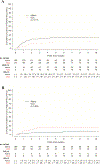Patterns and risk of recurrence in patients with esophageal cancer with a pathologic complete response after chemoradiotherapy followed by surgery
- PMID: 30655068
- PMCID: PMC6534488
- DOI: 10.1016/j.jtcvs.2018.09.136
Patterns and risk of recurrence in patients with esophageal cancer with a pathologic complete response after chemoradiotherapy followed by surgery
Abstract
Objectives: A pathologic complete response in patients with locally advanced esophageal cancer after chemoradiotherapy and surgery is associated with improved overall and disease-free survival. Nevertheless, approximately one third of patients with a pathologic complete response still have a recurrence. The aim of this study was to evaluate risk factors and patterns of recurrence in patients with locally advanced esophageal cancer who achieved a pathologic complete response after chemoradiotherapy and surgery.
Methods: We performed a retrospective review of a single-institution database of 233 patients with stage II and III esophageal cancer with a pathologic complete response after chemoradiotherapy and surgery between 1997 and 2017. A multivariable competing risk-regression model was used to identify predictors of recurrence.
Results: A total of 61 patients exhibited recurrence in this cohort, 43 with adenocarcinoma and 18 with squamous cell carcinoma. Five-year cumulative incidence of recurrence did not vary by histology. Univariable analysis revealed that poor tumor differentiation (hazard ratio, 2.28; P = .022) and advanced clinical stage (hazard ratio, 1.89; P = .042) are predictors of recurrence in the esophageal adenocarcinoma subgroup, whereas poor tumor differentiation remained the only independent predictor on multivariable analysis in the entire cohort (hazard ratio, 2.28; P = .009). Patients with esophageal adenocarcinoma had a higher incidence of distant recurrences, and patients with esophageal squamous cell carcinoma demonstrated a higher incidence of loco-regional recurrence (P = .039).
Conclusions: Poor tumor differentiation is an independent risk factor for recurrence in patients with esophageal cancer with a pathologic complete response. Although there is no difference in the cumulative incidence of recurrence between esophageal adenocarcinoma and esophageal squamous cell carcinoma, patterns of recurrence appear to differ. Thus, treatment and surveillance strategies may be tailored appropriately.
Keywords: esophageal cancer; neoadjuvant chemoradiotherapy plus surgery; pathologic complete response; recurrence; survival.
Copyright © 2018 The American Association for Thoracic Surgery. Published by Elsevier Inc. All rights reserved.
Conflict of interest statement
Figures




Comment in
-
Recurrence in complete responders after trimodality therapy in esophageal cancer.J Thorac Dis. 2019 May;11(Suppl 9):S1304-S1306. doi: 10.21037/jtd.2019.04.77. J Thorac Dis. 2019. PMID: 31245116 Free PMC article. No abstract available.
Similar articles
-
Neoadjuvant chemoradiotherapy with concurrent cisplatin/5-fluorouracil is associated with increased pathologic complete response and improved survival compared to carboplatin/paclitaxel in patients with locally advanced esophageal cancer.Dis Esophagus. 2017 Jul 1;30(7):1-7. doi: 10.1093/dote/dox015. Dis Esophagus. 2017. PMID: 28475724
-
A phase-II/III randomized controlled trial of adjuvant radiotherapy or concurrent chemoradiotherapy after surgery versus surgery alone in patients with stage-IIB/III esophageal squamous cell carcinoma.BMC Cancer. 2020 Feb 18;20(1):130. doi: 10.1186/s12885-020-6592-2. BMC Cancer. 2020. PMID: 32070309 Free PMC article. Clinical Trial.
-
Long-Term Survival and Recurrence Patterns in Locally Advanced Esophageal Squamous Cell Carcinoma Patients with Pathologic Complete Response After Neoadjuvant Chemotherapy Followed by Surgery.Ann Surg Oncol. 2024 Aug;31(8):5047-5054. doi: 10.1245/s10434-023-14809-1. Epub 2024 Jan 3. Ann Surg Oncol. 2024. PMID: 38172446
-
Patterns of recurrent disease after neoadjuvant chemoradiotherapy and esophageal cancer surgery with curative intent in a tertiary referral center.Eur J Surg Oncol. 2023 Oct;49(10):106947. doi: 10.1016/j.ejso.2023.05.022. Epub 2023 Jun 8. Eur J Surg Oncol. 2023. PMID: 37355392
-
Recurrence dynamics after trimodality therapy (Neoadjuvant concurrent chemoradiotherapy and surgery) in patients with stage IIIA (N2) lung cancer.Lung Cancer. 2018 Jan;115:89-96. doi: 10.1016/j.lungcan.2017.11.020. Epub 2017 Nov 22. Lung Cancer. 2018. PMID: 29290268
Cited by
-
Prognostic Role of Pathological Complete Response in Early Stage Epithelial Solid Tumors.Cancer Control. 2023 Jan-Dec;30:10732748231161466. doi: 10.1177/10732748231161466. Cancer Control. 2023. PMID: 37073789 Free PMC article. Review.
-
Soft-tissue metastasis in esophageal cancer managed by dose escalation radiation therapy: a clinical case and review of literature.Rep Pract Oncol Radiother. 2025 Feb 19;29(6):799-804. doi: 10.5603/rpor.104012. eCollection 2024. Rep Pract Oncol Radiother. 2025. PMID: 40104667 Free PMC article.
-
Development and Validation of a Radiomics Nomogram Model for Predicting Postoperative Recurrence in Patients With Esophageal Squamous Cell Cancer Who Achieved pCR After Neoadjuvant Chemoradiotherapy Followed by Surgery.Front Oncol. 2020 Aug 11;10:1398. doi: 10.3389/fonc.2020.01398. eCollection 2020. Front Oncol. 2020. PMID: 32850451 Free PMC article.
-
Immunotherapy Plus Chemoradiation Improves Overall Survival in Stage IV Esophageal Cancer: A Cohort Study.Gastro Hep Adv. 2023 Dec 12;3(3):302-310. doi: 10.1016/j.gastha.2023.12.004. eCollection 2024. Gastro Hep Adv. 2023. PMID: 39131143 Free PMC article.
-
Incidence and Risk Factors for Isolated Esophageal Cancer Recurrence to the Brain.Ann Thorac Surg. 2020 Feb;109(2):329-336. doi: 10.1016/j.athoracsur.2019.09.028. Epub 2019 Oct 12. Ann Thorac Surg. 2020. PMID: 31614136 Free PMC article.
References
-
- van Hagen P, Hulshof MC, van Lanschot JJ, et al. Preoperative chemoradiotherapy for esophageal or junctional cancer. N Engl J Med 2012;366:2074–2084. - PubMed
-
- Gebski V, Burmeister B, Smithers BM, Foo K, Zalcberg J, Simes J. Survival benefits from neoadjuvant chemoradiotherapy or chemotherapy in oesophageal carcinoma: a meta-analysis. The Lancet Oncology 2007;8:226–234. - PubMed
Grants and funding
LinkOut - more resources
Full Text Sources

